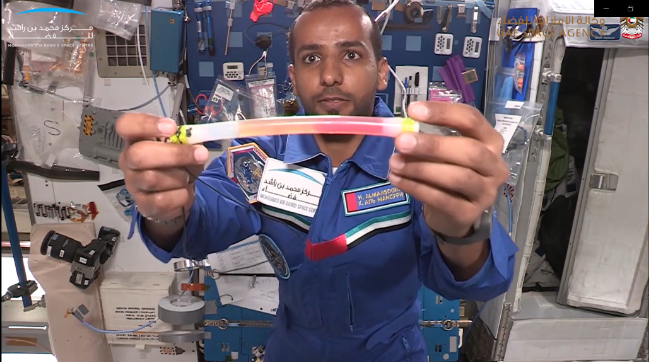Everyday science on Earth can be quite different from that in space because of the microgravity environment. Research and experiments on the International Space Station can help us understand how things work in space. We can model fluid dynamics, understand how plants grow or study the effects on the human body - all of which helps us move forward in our pursuit of deep space exploration. The UAE Space Agency manages the ISS Students Experiment competition that aims at sending several scientific experiments to the ISS in collaboration with university students and researchers.

Palm oil emulsification experiment:
An emulsion of solutions of different densities can readily be separated in 1G. Microgravity removes this ability and reveals fluid physics concepts such as surface tension. This experiment was conducted by Astronaut Hazzaa Al Mansouri during his scientific mission to the ISS in September 2019. It aims at demonstrating the behaviour of an emulsion of two immiscible fluids, palm oil and coloured water, in microgravity on the ISS and a 1G environment on earth.
Palm Seed experiment:
This experiment will establish the best methods for germination of palm tree samples to generate healthy tissue samples
for genetic and molecular biology research. It also includes the observation and documentation of root growth in microgravity for educational demonstration of gravitropism.
Space food for Bone Health:“SmoothISS”
A vitamin D fortified camel milk and date smoothie combines the relevant properties of local food resources with vitamin D and could represent a new tool to limit the effects of microgravity on bone mass. It also offers a familiar food for future Emirati space missions, a tasty food and a source of energy.
Camel milk contains carbohydrates, and some vitamin D. It also contains fat, an excellent food matrix to perform vitamin D fortification. Dates are an Emirati staple largely produced in the UAE, and rich in carbohydrates, a variety of vitamins, and minerals.
Effects of microgravity on Nitinol Coronary Stents:
Nitinol coronary stents are metal tubes placed in arteries that supply blood to the heart that expand against blocked or narrow walls. This experiment will study the effects of microgravity on Nitinol coronary stents and the ability of Nitinol to withstand the cyclic stress in microgravity.
Characterizing Human Immunodeficiency in Microgravity Environments:
This experiment aims to better understand a possible pathway of immune system suppression in space by using gene-expression analysis and imaging to study the differentiation and activation of macrophages in microgravity.